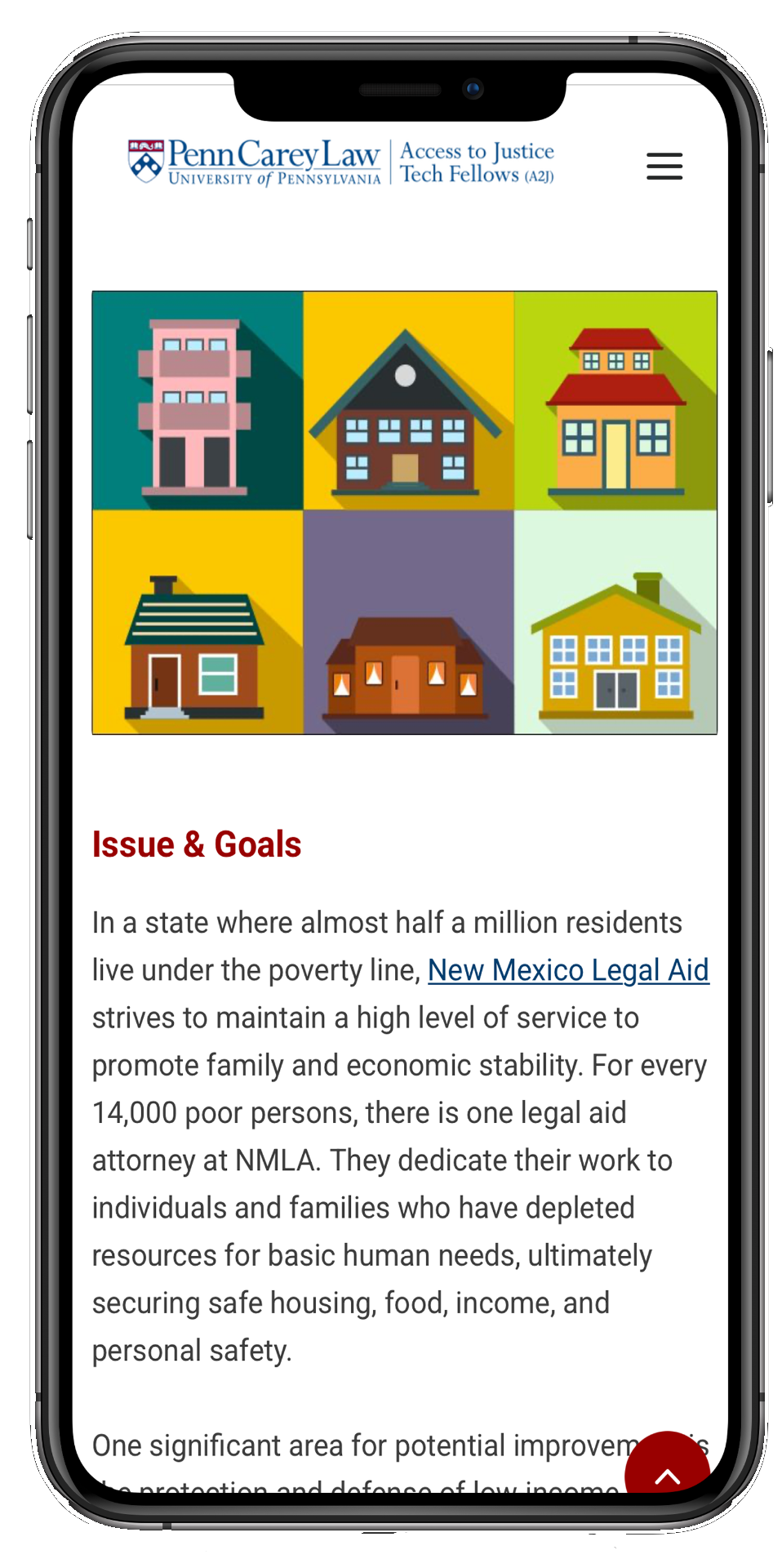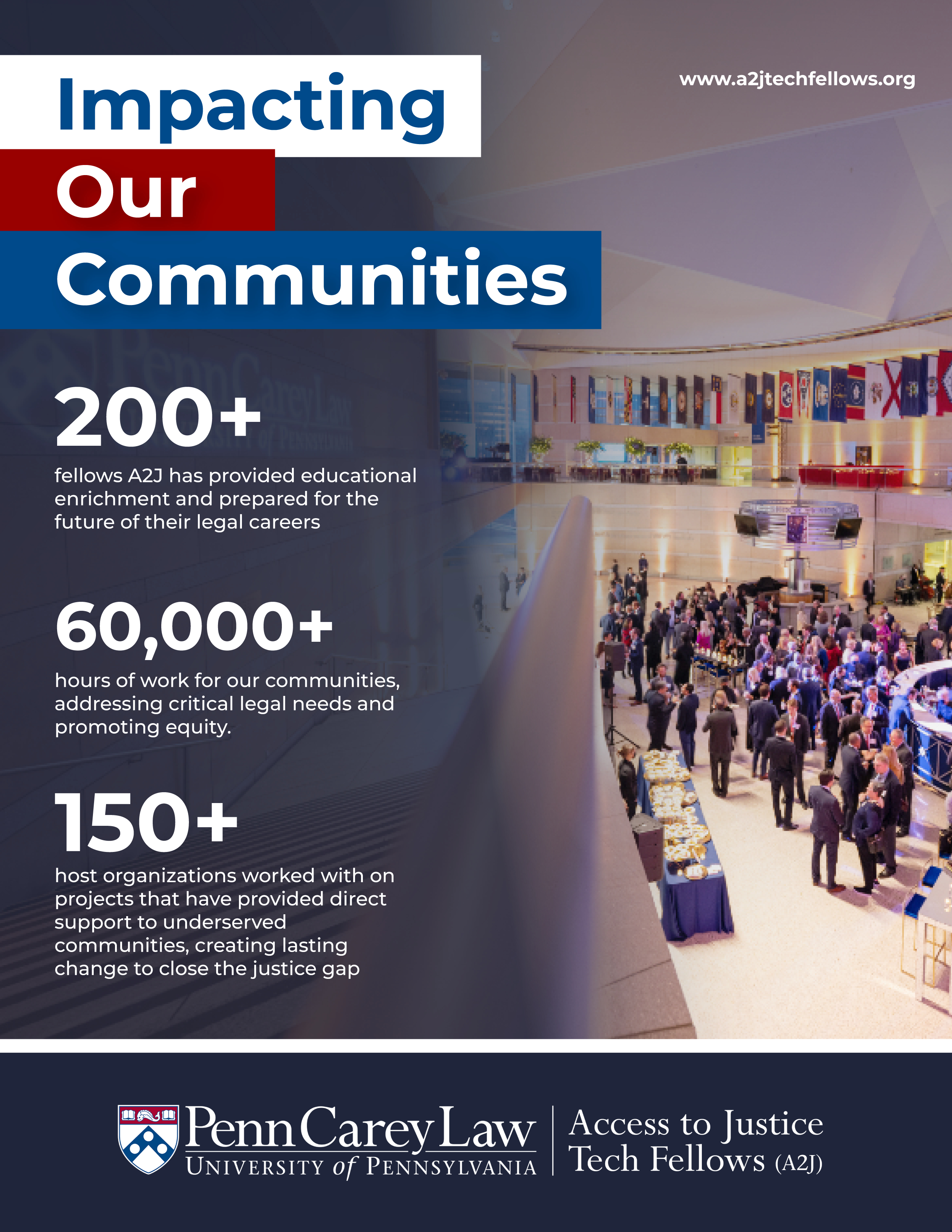![[interface]](https://cdn.prod.website-files.com/68365071d27bf728b79fbd5b/68769d5dc762d3c36f527d1e_Copy%20of%20Print%20Flyer%20for%20Fellowship%20Informational%20Event-wedt.jpg)
University of Penn's Access to Justice Fellowship
Designing for impact— helping A2J Tech Fellows secure the future of the program and the next generation of justice-driven lawyers.
Designing for impact— helping A2J Tech Fellows secure the future of the program and the next generation of justice-driven lawyers.
![[interface]](https://cdn.prod.website-files.com/68365071d27bf728b79fbd5b/68769d5dc762d3c36f527d1e_Copy%20of%20Print%20Flyer%20for%20Fellowship%20Informational%20Event-wedt.jpg)
Designing for impact— helping A2J Tech Fellows secure the future of the program and the next generation of justice-driven lawyers.
From the start, I was deeply inspired by the mission of the Access to Justice Tech Fellows program (A2J)—a national program, currently operating out of Penn Carey Law, dedicated to equipping law students with the tools & technology to help expand legal access for systematically marginalized communities.
Brought in at the prototype stage, I worked to refine the design, making sure the platform was not only functional but truly intuitive and accessible across desktop and mobile. I cared deeply about creating a seamless experience so that host organizations and fellows could easily navigate resources, connect with mentors, and become excited and motivated to join the program. Beyond UX improvements, I also managed multi-channel visual assets, ensuring brand consistency across digital and print media.
The final product supported recruitment, enhanced public trust, and gave the fellowship a much-needed digital home to amplify their mission and impact. It featured significantly improved usability and inclusivity—helping advance ATJ Tech Fellows' incredible work in supporting the next generation of justice-driven lawyers. By improving the design and user experience, I helped showcase the initiative’s success and alignment with its mission, ultimately strengthening the case for leadership to continue the fellowship for another year.
The Penn Access to Justice (A2J) Fellowship, part of the national A2J Tech Fellows initiative, supports law students and legal professionals working to close persistent justice gaps in the United States. With a mission to expand legal access for systemically marginalized communities, the program equips fellows with the tools, mentorship, and real-world opportunities needed to build a more equitable legal system.
When I joined the project in late 2024, the Fellowship had no dedicated digital presence. Key information was scattered across PDFs, event pages, and slide decks, making it difficult for applicants, mentors, and partner organizations to understand the full scope and impact of the program. The team recognized the need for a centralized, accessible, and user-friendly website to strengthen visibility, highlight fellows’ achievements, and communicate the program’s value to stakeholders.
The A2J team needed a public-facing website that communicated their mission, showcased the work of current and past fellows, and provided clear pathways for applicants and partners to get involved. They were on a tight timeline to get the site live in time for fellowship promotion and stakeholder visibility, and the project needed to meet accessibility standards and present a trustworthy, polished digital experience. This project required me to:
Early user and stakeholder feedback revealed several key insights:
While users appreciated that the site centered on the fellows and their work, the original messaging felt too focused on Penn, despite the fellowship’s national scope. Users wanted clearer evidence of real-world impact, broader geographic reach, and how the program connects across jurisdictions. This feedback informed the following core design goals:
Content Audit & Site Architecture
I synthesized scattered documents and assets into a coherent, accessible site structure. This included defining main navigation, user flows, and accessibility requirements from the start.
.png)
Usability Testing & Interviews
Stakeholders and fellows were involved early in shaping the information architecture and validating usability. User interviews were conducted throughout the process to guide iterative improvements before final implementation.

Webflow Development & Iterative Design
After quickly onboarding myself to Webflow, I prototyped live components to accelerate testing and apply accessibility best practices in real time—such as semantic structure, heading order, and alt text.
Key Iteration: Contextual Content for Deeper Engagement
User feedback revealed a need for more context about the program’s structure and impact. I expanded on-site content to better explain the fellowship’s value and added new sections combining infographics and fellow stories to highlight nationwide reach.

Product & Visual Design Support
I created branded flyers, social graphics, and digital assets to support program announcements and events. These assets were used across platforms and incorporated into formal impact reporting.
Product Management & QA
Using Jira and Google Suite, I managed tasks, collaborated with cross-functional teams, and led quality assurance efforts. This included auditing deliverables, manually testing accessibility, and ensuring WCAG compliance site-wide.
Site Content & UX Architecture
Consolidated content from scattered documents and rewrote it into 14+ clear, high-impact pages. Improved overall user flow by combining redundant sections, streamlining navigation, and validating structure and clarity through user research.
Accessibility Enhancements
Ensured WCAG compliance by adding descriptive alt text, correcting heading hierarchy, improving semantic HTML structure, and reducing non-essential interactive elements like carousels. Styled all buttons and accordions for optimal screen reader compatibility and conducted both manual and automated accessibility testing.
Visual & Interaction Design
Designed key visual elements—including fellow spotlights, infographic-style impact sections, and custom illustrations—using Canva and Figma. Managed an external Penji design team, overseeing all design edits and completing 100% of the required digital assets by project close.
Technical & Platform Improvements
Resolved responsive design issues across breakpoints, refined mobile menu styling, and ensured consistent use of typography, color, and layout across the site. Enhanced SEO site-wide and implemented Mailchimp newsletter templates to support ongoing program communications.
User Testing & Iteration
Led usability testing sessions that directly informed improvements in navigation clarity, message hierarchy, and overall accessibility. Iterated on layouts and content based on feedback from stakeholders, fellows, and prospective applicants.
This project brought together everything I care about as a designer: expanding access, telling real-world stories with clarity and care, and building systems that empower both users and internal teams.
The site launched successfully as a centralized hub for the Penn A2J Fellowship, strengthening the program’s visibility and helping secure support for its continued growth. Fellows and mentors could now navigate resources more easily, and stakeholders had a clearer platform to communicate the initiative’s national impact.
Design choices carry narrative power.
Every element, from page layout to copy tone, shapes how people understand the mission and scope of a program. This project reminded me that design is a storytelling tool, especially when justice and access are on the line.
Content architecture is design.
Reorganizing dense, fragmented materials into a clear and accessible site structure was just as impactful as any visual refresh. It improved usability, internal collaboration, and long-term maintainability.
Progress over perfection.
Working under time pressure pushed me to prototype in Webflow while learning it on the fly. I prioritized accessibility from the start, leaned into iterative releases, and focused on delivering what mattered most; even if it wasn’t pixel-perfect at first.